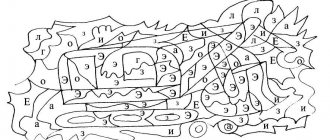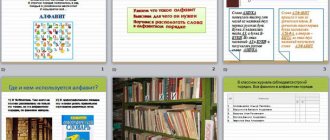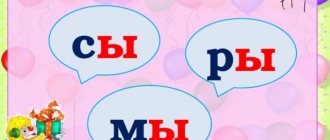"Sound and letter A." Literacy lesson ⋆ Planet of Childhood
Program content:
- introduce the sound and letter A;
- develop articulatory and finger motor skills. Develop phonemic processes: distinguishing onomatopoeia and everyday noises, identifying the isolated sound A among others, identifying the sound at the beginning of a word. Develop constructive praxis, visual perception;
- cultivate cognitive interest through playful moments.
EQUIPMENT: laptop, computer game “Learning to speak correctly” from the “Soon to school” series; symbols of vowel sounds, photo album; surprise picture; individual mirrors; subject pictures for sound A; subject pictures whose names begin with the sound A and other sounds; the letter a; "Magic" squares according to the number of children.
LITERARY SERIES: poem about the letter A.
PROGRESS OF THE CLASS
I. Organizational moment.
— Guys, which of you likes to play computer games? Today I brought you an interesting game, only very attentive guys can play it. Which one of you is attentive?
(Children sit together with a speech therapist in front of a computer. A game to differentiate onomatopoeia, household noises and sounds of nature. Children take turns playing the game).
II. Report the topic of the lesson.
- Guys, now you listened carefully and guessed the sounds that can be heard on the street, the sounds that objects and animals make. But now a sound will come to visit us, which cannot be produced by objects and animals; only a person can pronounce it. Meet us, guys, the sound A has come to us. He loves to sing and at the same time opens his mouth very wide.
(The sound symbol A is set).
- Guys, sound A really wants to meet you and make friends. He didn’t come to us empty-handed, but brought a surprise with him - a picture, but he doesn’t want to just give it away, but wants to play with you. Sound A has prepared interesting tasks for you and for each completed task it will give you one part of the picture. And when you complete all the tasks, you will be able to collect the picture.
III. Introducing the sound symbol A.
— Friends usually show each other albums with photographs. So sound A brought us his album, let's look at it: here are photographs of sound A and his friends. Let's find photos of sound A.
(Joint viewing of the album with children)
- Well done, you found all the photographs of sound A. For this you get one part of the surprise - pictures.
IV. Conjugate gymnastics.
- And now the sound A wants to teach us to sing just like it, for this we need to train the niches of the lips, and our fingers will help us. We will do the exercise “Chicks in the Nest”.
a) “Nest”;
b) “Chicks.”
V. Characteristics of sound A in front of a mirror.
(Each child has an individual mirror).
- Now we will also learn to open our mouth wide in the same way as the sound A: the mouth is wide open, looks like a circle, the tongue calmly lies below the lower teeth, the song stretches on, does not meet any obstacles, a vowel.
- Well done, guys, it’s great that you can sing like the sound A. For this you get another part of the picture.
VI. Onomatopoeia.
- Sound A is very important, we can’t live without it: - What does the doctor ask you to say when he looks at the neck? (Ahhh) - How does a mother rock her baby? (Ahhh)
VII. Development of phonemic hearing.
a) distinguishing a sound from a number of others: “Let’s clap for sound A”:
- And now sound A wants to sing for us, and when we hear his song, we will clap for him, and if you hear other sounds, then there is no need to clap.
- Well done, for being such attentive listeners, sound A gives you another part of the picture.
b) isolating a sound from the beginning of a word: “Let’s give postcards to sound A”:
- And now we will make a gift for sound A. We will give him cards. You need to select only those with objects whose names begin with the sound A.
- Sound A really liked your postcards, for this he gives you another part of the picture.
VIII. Introducing the letter A.
a) analysis of the appearance of the letter:
- Where did the sound A come to us from? He has a house, he lives there, and this house is called the letter A. Here it is.
(The letter A is placed on the board. Children express their opinions on what the house near the sound A is like. Then the adult introduces everyone to the poem):
“A” hut, look,
And a bench inside.
b) constructing the letter A from the “Magic Square”:
- Let's build houses for the sound A - Letters A. We will build the same letter A from triangles and stripes as on the postcard.
- You made wonderful letters A. Here is another part of the picture.
c) recognizing the letter A in a plot picture:
- Sound A really liked playing with you, but it’s time for him to return home, and here’s his last task: we need to take our new friend home - find all his houses - the letters A in this picture.
(Children get up from their seats, approach the story picture and each finds one letter).
- Well done, guys, you completed all the tasks and you have all the parts of the picture - a surprise, let's collect it. Let's thank our guest and see him off.
IX. Summary of the lesson.
(The summary of the lesson is based on the collected picture, which depicts the letter a and a stork)
— What sound came to visit us today?
— What is the name of the house of sound A?
- What funny rhyme did we learn about the letter A today?
- Why did our new friend draw a stork in this picture?
Author: Andronova Natalya Andreevna teacher-speech therapist, MBDOU compensatory kindergarten No. 100 “Bereginya” Russia, Irkutsk region, Irkutsk.
The article is published in the author's edition.
planetadetstva.net
Summary of the lesson “Sound and letter A”. Lesson on generalization and systematization of knowledge
Topic: sound and letter A.
Lesson type: lesson of generalization and systematization of knowledge.
Goal: to systematize students’ knowledge about the vowel sound and the letter A.
Educational: - Continue to teach how to isolate the vowel sound [A] and designate it with a letter.
Corrective and developmental: - Form finger and articulatory motor skills - Develop phonemic perception and representation. — Form sound-syllable analysis and synthesis. — Continue to work on developing kinesthetic sensations. — Correct thinking based on practicing the operation of analysis and synthesis. — Develop the perception of shape by working with geometric shapes. — Use health-saving actions to maintain performance and expand the functional capabilities of the students’ body (dance of vowels, physical exercises, alternation of various types of activities). — Correct attention based on the formation of the ability to distribute.
Correctional and educational: - To develop the ability to understand and accept an educational task posed in verbal form; — Continue to learn how to answer questions during the course of study with adequate use of the learned terminology. — Develop the ability to actively comprehend the material covered.
Equipment: Demonstration material: PC, PP presentation. Handouts: Mirrors, match sticks, homework cards.
Progress of the lesson:
1. Organizational moment The one who recognizes the geometric shapes will sit down.
2. Articulation gymnastics Let's prepare our tongues for work.
3. Finger gymnastics Work with sticks. Laying out figures according to the pattern. Clarification of the name.
4. Work in a notebook in a square Sketching an oval. Hatching the oval from left to right.
5. Repetition of what has been covered Vowel sounds - they sing, dance, do not meet obstacles. Those who agree stumble upon everything, they stumble over everything. Consonants encounter obstacles in the form of lips, teeth, and tongue.
6. Guessing the topic of the lesson. Pronunciation. Proof. Dance. Sound dance: the child stands, holds his hands in front of him in the shape of a wide oval.
7. Working with the articulatory profile Determining the position of the lips, teeth, tongue, and the functioning of the vocal cords when pronouncing a sound. Conclusion: The sound is a vowel.
8. Work with signal cards and in notebooks. Search for the sound [A] in words. If there is [A] in the word - a card with a + sign, if not - with a sign - Orally: army, cat, fish, shower, mushroom, bull, March. In writing: table, sled, hole, scales, smoke, roof, hand.
9. Listening to an audio recording about the sound and letter A. Recording the topic of the lesson.
10. Aunt Owl’s story about the letter A Finding out which words you remember. Clarification of the lexical meaning of these words.
11. Reading forward and backward syllables (choral, in turn) Writing any two syllables in a notebook. We write down the letters of vowel sounds with a pen with red ink.
12. Phys. pause o/r Hammer-hamster hamster (make movements according to the text) Striped flank. The hamster gets up early, washes his cheeks, rubs his neck. Khomka sweeps the hut and goes out to exercise. One, two, three, four, five, Khomka wants to become strong.
13. Working with pictures from the monitor screen. (At the board and in the notebook). Recognition of objects. Recording the names of objects with pronunciation on the board and in a notebook. The letters of vowel sounds are in red. Division into syllables. Repetition of the rule: the number of vowels in a word, the number of syllables.
14. Lesson summary
Presentation for the lesson notes “Sound and letter A”
| The presentation on slide 20 has a link to the video below. You can download the original presentation file. |
Video for lesson notes “Sound and letter A”
Also on topic:
logoped18.ru
![Summary of a lesson on speech development for children 4–5 years old “Sound culture of speech: letter [p]”](https://dou31-orel.ru/wp-content/uploads/konspekt-zanyatiya-po-razvitiyu-rechi-dlya-detej-4-5-let-330x140.jpg)




